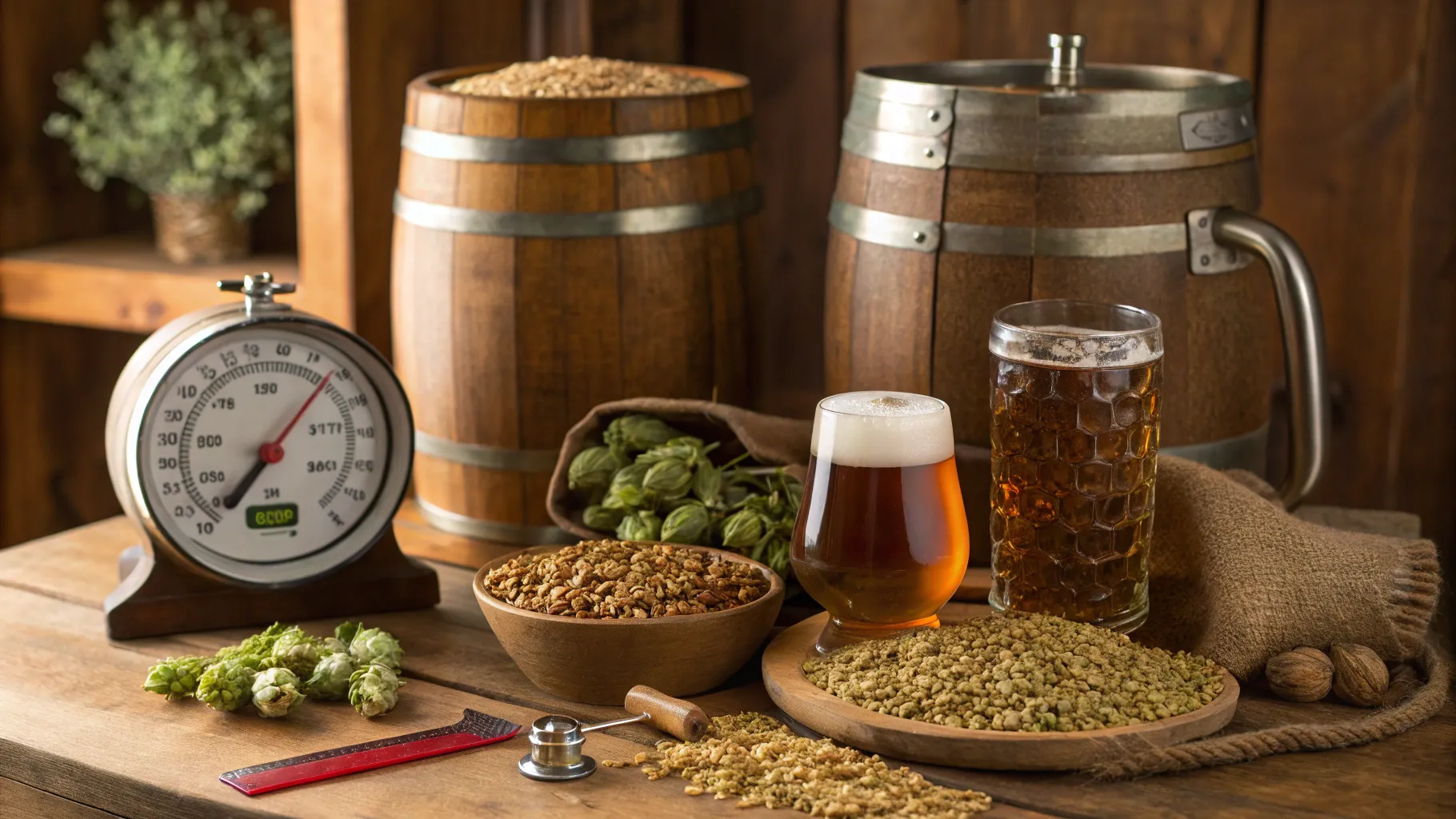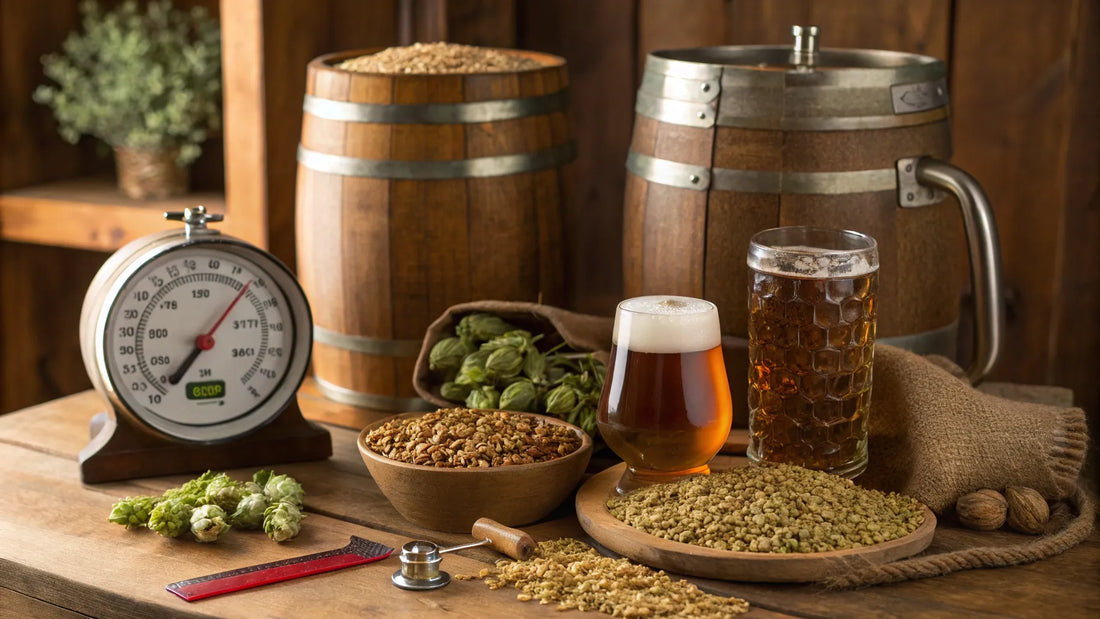Five tips for successful fermentation of craft beer

In this blog, we share five essential tips for fermenting craft beer, based on our experiences and insights from experts. From choosing the right yeast to maintaining the perfect temperature, these tips will help you create delicious beers.
Introduction 🍻
Welcome to the world of craft beer! Fermentation is a crucial process that forms the basis for creating unique and delicious beers. This article provides insights and tips to optimize your fermentation process, so you can enjoy the perfect pint.
What is fermentation?
Fermentation is the process by which yeast converts sugars into alcohol and carbon dioxide. This happens when yeast feeds on the sugars in your wort. The result? A delicious alcoholic drink that will surprise your friends and family!
The importance of fermentation 🍺
Fermentation is not just a step in the brewing process; it is the phase where the magic happens. The flavor, aroma, and alcohol content of your beer are all shaped during this crucial period.
Why is fermentation so important?
- Alcohol production: The yeast converts sugars into alcohol, which is essential for any beer.
- Flavor development: During fermentation, complex flavors and aromas arise that make your beer unique.
- Carbonation: The carbon dioxide released during fermentation creates the fizz in your beer.
Useful nutrients for yeast 🍇
A healthy yeast is the key to a successful fermentation. Yeast needs nutrients to function well and produce the right flavors.
Which nutrients are important?
- Zinc: Essential for the enzymatic activity of yeast.
- Nitrogen: Helps with the growth and reproduction of yeast cells.
- Vitamins: B vitamins are crucial for the yeast to function properly.
How can you add these nutrients?
There are several ways to add nutrients to your roots. You can buy ready-made yeast nutrients or make a mixture yourself with ingredients such as dried yeast or special nutrients.
Add the right amount of yeast 🍻
Adding the right amount of yeast is crucial for a successful fermentation. Too little yeast can lead to a slow or incomplete fermentation, while too much yeast can cause undesirable flavors.
How do you determine the right amount of yeast?
Use a yeast calculator to determine how much yeast you need based on the specific gravity of your wort. For an average beer, you can usually assume one packet of dry yeast per 20 liters.
Tips for adding yeast
- Activate: First activate your dried yeast in a small amount of wort before adding it to the main batch.
- Temperature: Make sure the yeast is at room temperature before adding it to your wort.
- Freshness: Always use fresh yeast for the best results.
Temperature control during fermentation 🌡️
Temperature is one of the most important factors that influence fermentation. Having control over the temperature can make the difference between a good and a bad beer.
Why is temperature control so important?
Each type of yeast has an optimal fermentation temperature. Too high or too low temperatures can lead to undesirable flavors or even a stalled fermentation.
Tips for temperature control
- Location: Choose a cool, dark place to put your fermenter.
- Insulation: Use an insulating cover or blankets to keep the temperature stable.
- Thermometers: Use a digital thermometer to accurately monitor the temperature.
By paying attention to these important aspects of the fermentation process, you can significantly improve the quality of your craft beer. Don't forget that each brewer develops their own unique style and techniques, so experiment and discover what works best for you!
Use of seasons for fermentation 🌱
The seasons can play a big role in your fermentation process. By adjusting your brewing activities to the seasons, you can optimize the conditions for the yeast you are using.
How seasons influence fermentation
In the summer, for example, you can brew beers that thrive at higher temperatures, such as saisons. These yeast strains are heat-resistant and can even develop extra flavors at higher temperatures.
In autumn and spring, everything is ideal, allowing you to maintain a constant room temperature of about twenty degrees. This is perfect for most types of yeast.
Tips for seasonal brewing
- Use the natural temperature: Place your fermenter in a space that provides the right temperature for the yeast you are using.
- Take temperature variations into account: Make sure your fermenter is not near radiators, as this can lead to fluctuations in temperature.
- Use insulation: In winter, you can wrap your fermenter with blankets to maintain the temperature.
The importance of a dark environment 🌒
A dark environment is crucial for fermentation, especially when working with hop-rich beers. Light can cause unwanted reactions that can affect the flavor of your beer.
Why is darkness important?
UV light can lead to light damage, resulting in undesirable flavors, such as a "light-strike" effect. This can significantly reduce the quality of your beer.
How do you create a dark fermentation environment?
- Use cover: Cover your fermenter with a light-proof cover or use a dark bucket.
- Choose the right location: Place your fermenter in a spot where it is not exposed to direct light.
- Use dark bottles: If you bottle your beer, use dark bottles to minimize light damage.
Sanitation tips for home brewers 🧼
Sanitation is one of the most important steps in the brewing process. Poor sanitation can lead to infections that make your beer undrinkable.
Essential sanitation practices
Always start with a clean workspace. Make sure that all equipment, from your fermenter to your pipes, is thoroughly cleaned and disinfected.
Tips for effective sanitation
- Heat and rinse: Use hot water to clean your equipment before disinfecting it.
- Use a disinfectant: Products like Star San are effective and easy to use.
- Be thorough: Take the time to clean everything properly. You can't disinfect too much!
The role of hygiene in the brewing process 🚿
Hygiene plays an essential role in every step of the brewing process. From boiling your wort to bottling, each phase requires attention to hygiene.
Why is hygiene so important?
Unhygienic conditions can lead to bacterial infections and unwanted flavors in your beer. This can make all your efforts in vain.
Hygiene tips for homebrewers
- Wash your hands: Make sure your hands are always clean before working with your equipment.
- Disinfect your environment: Keep your work surface clean and free from contaminants.
- Check your equipment: Make sure all your equipment is properly cleaned and disinfected before you start.
Too much yeast: what to do? 🚫
Too much yeast can lead to undesirable flavors and incomplete fermentation. It is important to know how to prevent this and what to do if it happens.
How do you recognize too much yeast?
One of the signs of too much yeast is a strong smell of chlorophenol, which may indicate slow or incomplete fermentation.
What to do if you have added too much yeast
- Check the fermentation: Keep an eye on the fermentation and see if it gets off to a good start.
- Adjust the temperature: If fermentation is slow, it can help to slightly increase the temperature.
- Use a yeast starter: For future brews, consider making a yeast starter to improve yeast activity without adding too much yeast.
Biotransformation and dry hopping 🍃
Biotransformation is a fascinating process that occurs during fermentation, especially in the making of hoppy beers. It is the interaction between the yeast and the hop components that can create new and complex aromas. This is particularly important in New England IPAs, where we strive for that creamy, fruity flavor that is so desired.
An effective way to stimulate biotransformation is by timing your dry hopping. By adding a portion of your hops during active fermentation, when the yeast is at its peak, you can take advantage of this interaction. The result? A richer and more layered flavor experience.
"It is important not to add too much hops at once. A light addition of about 10-20% of your total hop quantity can already make a big difference. This ensures that the yeast has time to react without you having to deal with unwanted grassy aromas."
Experiences with dry hopping 🌊
"My experiences with dry hopping have evolved over the years. Initially, I was hesitant to experiment with this technique, but now I see it as an essential step in the brewing process. Adding hops during fermentation has taken my beers to a new level."
"When working with dry hopping, I have learned that timing and temperature are crucial. Adding hops at the right moment can significantly enhance the flavor and aromas of your beer. I have discovered that adding hops at the peak of fermentation, when the yeast is most active, yields great results."
But it's not just about adding hops; it's also about patience. Let your beer take the time to develop the flavors. This can vary from 24 to 48 hours, depending on your recipe and the types of hops used.
Risk of hop creep ⚠️
An important consideration in dry hopping is the risk of hop creep. This phenomenon occurs when the yeast breaks down certain sugars from the hops and initiates fermentation again. This can lead to unwanted carbonation and even a change in the flavor of your beer.
To minimize hop creep, it is essential to control your fermentation properly. If you notice that your beer develops too much carbonation after adding hops, it may be necessary to adjust your temperature or perform a cold crash.
An effective strategy is to let your brew rest after the dry hop process. This gives the yeast the chance to break down any residual sugars and helps stabilize your beer before you bottle it.
Conclusion and encouragement 🎉
Fermentation is the key to making exceptional craft beer. By paying attention to every aspect of this process, from biotransformation to dry hopping, you can improve the quality of your brews. Remember that every experiment brings you closer to the perfect pint.
"I encourage all homebrewers to keep learning and experimenting. Every brew is an opportunity to discover something new. So get to work, apply these tips, and enjoy the journey to making your ideal beer!"





